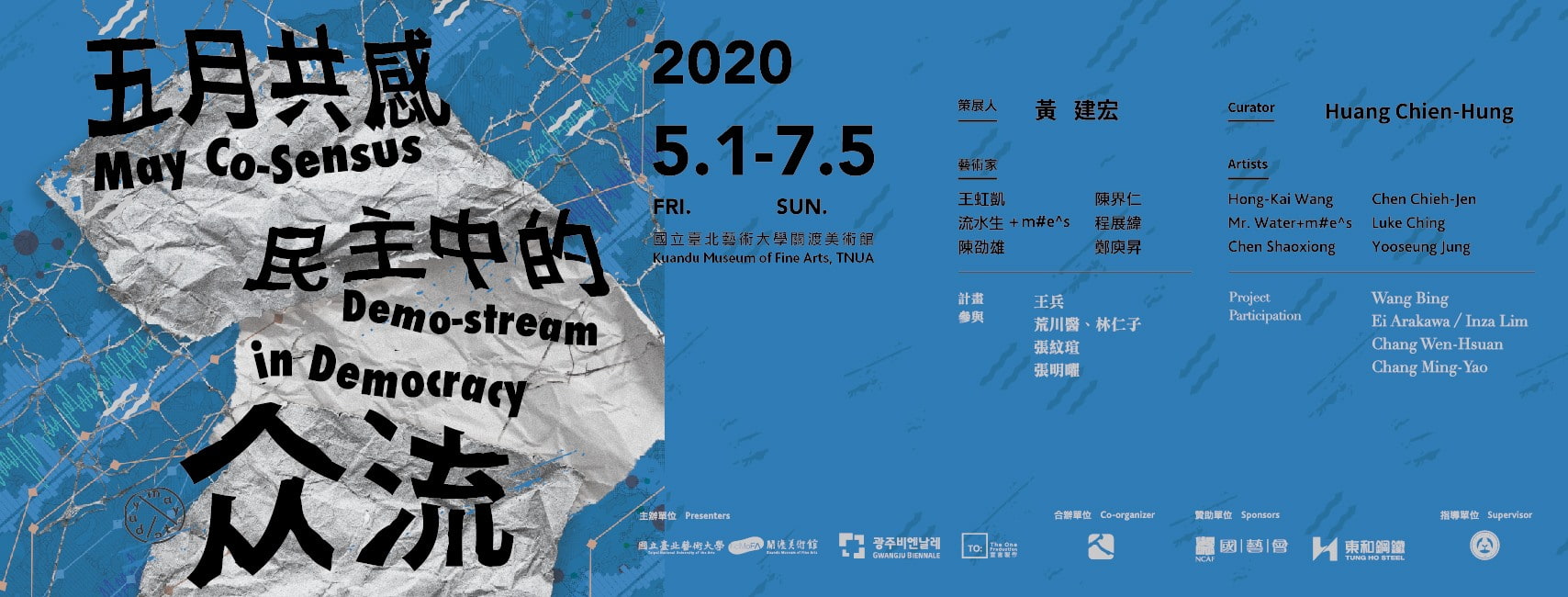Curator:Huang Chien-Hung
Project Participation: Wang Bing, Ei Arakawa/Inza Lim, Chang Wen-Hsuan, Chang Ming-Yao
Presenters: Kuandu Museum of Fine Arts, TNUA, Gwangju Biennale Foundation, The One Production
Co-organizers: National Human Rights Museum, Gwangju Information and Culture Industry Promotion Agency
Sponsors: National Culture and Arts Foundation, Tung Ho Steel Foundation
Supervisor: Ministry of Education
Venue: 4F, 1F Outdoors
Curatorial Statement
The Return of Fascism
“Decolonization” and “human rights” constitute the double helix structure of the 20th-century global politics. As time flies, we have been accustomed to freedom, equality, and democracy within a century. However, at the turn of the century, political sophistry and the use of force made these elements ambiguous or abnormal. Moreover, all kinds of social and livelihood problems caused by the previous criticism of capitalism led by the left-wing ideology have mostly shifted to the question about democracy. As a result, democratic societies have turned to support conservatism, which is dominated by regional interests. Fascism beyond the left and right wings has appeared all over the world.
The Clustering of Multi-layer Co-sensus
The broad left lost its ability to call for “co-sensus” which it once obtained in the late 19th century and the 1960s, and 1980s. In contrast, we have measured the “co-sensus” with the method which is simplified by online social media; hence, “populism” has become a double-edged sword of the digital age. The anti-extradition protests in Hong Kong, as well as social movements in Turkey, Ukraine, Indonesia, India, and Iran, are all anarchy movement struggling against the fascistization. Yet, most rightist regimes have ignored or even suppressed those movements forcefully. The global-infected 2019 novel coronavirus has dramatically interrupted the predicament. Many rightist or totalitarian countries have run into domestic affairs crisis due to intransparent information and face news operations.
The political life that we must confront and contemplate today is the creativity that gathers and goes beyond populism. “Multitude” as a “cluster” in a decentralized era has become a major desire and anarchic imagination for social solidarity and mobilization. However, meanwhile, the “i” ideology in the business market also swept across the entire market. Coupled with the “computation” of the online social networking service, “collective” is bound to be difficult to happen in such offset. Apparently, the emotivity and memes contribute to the relational flux, and thus generate clustering and collectivity. In short, clustering is not the condensation and completion of identity, but the “co-sensus” event before identity is represented.
The Dynamic Unit of Demo-stream: Be Water
The force and energy of emotivity precipitate the flow. The undertaking of the flow (the act of emotivity) is thus the event in the gathering process, which is the co-sensus that we wish to create and capture through artistic means. Nevertheless, difficulties in “co-sensus” or the “deprivation of perception” that we confront today operate not through structural relationships but the stripping of microelements (affect), the artificial implanting of “memes,” and the general elements massively substituted to specific language interfaces. Therefore, it is relatively necessary to stimulate the “sharing” benefits of micro-elements with “emotivity” that precipitate the flow.
If the late 1980s was an important period for the collapse of the Cold War and full democratization, in this global political atmosphere, many anti-dictatorship movements and demands for freedom have taken place in both South Korean and Taiwan, urging the government to lift martial law and authoritarian regimes. However, the democratic co-sensus demo-stream clustered in the 1980s did not become central to the narrative of the time; while today’s multi-layer co-sensus allows us to look back at the hidden comprehension. In fact, individuals trigger event clustering with creative co-sensus, which makes the gap sensible and connects the unconnected of the distribution. This was the case forty years ago, and so it is today. Now, we do have a deeper feeling that “democratization” requires a kind of ability to adjust to differences and to accommodate them. The concept of “be water” operated in the anti-extradition protests as a “token” connecting the emotivity, flow and democratic dynamics provide such a technique example.
The Season of Demo-stream
If “be water” (Bruce Lee) is the essence of the agency within martial arts, we can even take it as the basic force of democracy. It refers to that “individuals” enter the public space intensified by politics, and then flexibly connect with other individuals to achieve certain efficiency and exert a certain power. The individual would further connect to an operational relationship that can adequately respond to the appearance of the external environment. “Be water” is able to surpass dilemmas of many democratic societies and directly link up an active relational network, delivering reinforced information, communicating emotions and sharing experience. Hence, “be water” directs toward “demo-stream” through “co-sensus.”
“May” was significant in the year of 1919 in China, in 1968 in France, in 1980 in South Korea, and 1988 in Taiwan. The energy of change and youth occupied in “May” in the 20th century, since the climate in “spring” is suitable for going out, meeting new friends, expressing ourselves, and speaking up. Now, we are facing May of the 21st century. When we recall those “Mays” of the 20th century, we do dream of going out to make friends again and vibrate the world with a more delicate mind. Through “Demo-stream,” we aim to find more layers in this energetic convergence and movements from artists’ though and practices. We try to put forward the ecological view of democratization in the bio-political period. The democratic movement also represents the emergence of new concepts of common life, new perceptual distribution, and a new world of common existence.
